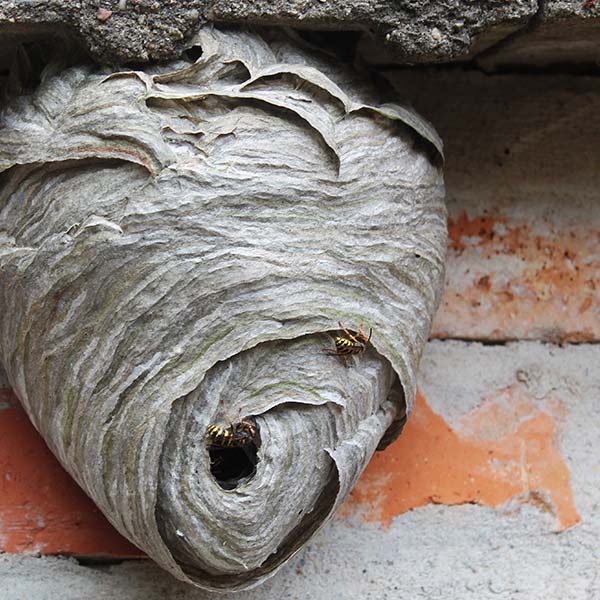Wasps, Hornets & Bees Pest Control
Wasps, Hornets & Bees Exterminator
Ecopest treats Wasps, Hornets and Bees nests by sprinkling pesticide dust into the entrance. As the wasps, hornets, and bees enter and exit the nest, move around the nest, and clean it, the dust spreads throughout the nest, killing all occupants. People should avoid the next for an hour or two after treatment as the wasps, hornets and bees will be agitated and angry and likely to sting. To be treated, the entrance to the nest needs to be evident so that we can find it, it needs to clear so that the wasps can pick up the dust, and the weather needs to be warm and dry so that the wasps are active and moving around so that they will spread the dust around. Usually, one treatment is needed, but if wasps and bees are still active 48 to 72 hours later, then a second treatment is required.
When a pest problem becomes out of control, it is necessary to contact a professional agency such as Ecopest. For Wasps, Hornets and Bees removal, Ecopest is the most trusted pest control company in Canada. As the undisputed experts in pest control service, we have considerable experience dealing with all sorts of wasps and bees removal in Calgary, Edmonton, Regina, Saskatoon, and throughout Canada.
Contact Us Today!

Wasps, Hornets and Bees Facts
Although wasps, hornets and honey bees are helpful insects, people regard them as pests due to their propensity to sting. Wasps, in particular, are a nuisance in the autumn, disrupting a variety of outdoor activities. People often mistakenly call all stinging insects “bees.” While social wasps and bees live in colonies ruled by queens and maintained by workers, they look and behave differently. It is essential to distinguish between these insects because different methods may be necessary to control them if they become a nuisance.
Appearance
Wasps have a thin body, a small waist, slender, cylindrical legs, and smooth, glossy skin. In comparison to wasps, bees have a larger body and more hair. Their hind legs are flattened for collecting and transporting pollen. Bees are essential pollinators. Honey bees are responsible for more than 80% of the pollination required by most fruits, legumes, and vegetable seed plants as well as many ornamentals that are grown in our landscapes.
Our service professionals understand and can give discreet and targeted Wasps and bees control over the many varieties of Wasps and bees. For Wasps and bees removal, we are the most trusted pest control company. As the undisputed experts in pest control service, we have considerable experience dealing with all sorts of wasps and bees removal in Regina, Calgary, Edmonton, Saskatoon, and throughout Canada.
Nesting Sites
Nests are frequently discovered beneath stairs, in crevices in building foundations, shrubs and trees, soffits, eaves troughs, and even in the ground.
Wasp and Bee Stings
Wasps and bees sting to protect themselves or their colonies. Insects sting by injecting a protein venom, producing pain and other responses. Wasps and bumblebees can sting more than once because they can pull out their stinger without injury to themselves. The stinger is not left in your skin if you are stung by a wasp or bumblebee. Most people have only local reactions to wasp and bee stings, although a few may experience more serious allergic reactions.
Wasps, Hornets & Bees FAQs
FAQ – Frequently Asked Questions – Wasps & Bees
There are several varieties of wasps in Canada, including the yellow jacket, hornet and paper wasp. Colour ranges from black to combinations of black with yellow, white or brown markings. The slim, winged body measures 10 to 15 mm (1/2″ to 3/4″).
Bees have enlarged hind feet, typically equipped with pollen baskets of stiff hairs for gathering pollen. They usually have a dense coat of feathery hairs on the head and thorax. In many, the lip forms a long tube for sucking nectar.
Honey bees leave their sting behind in your skin, which continues to pump venom into you for a few minutes. Therefore, you should scrape it off straight away with something with a straight edge. Stings hurt for a while and may itch for a few days, but usually, there are no severe effects. However, some people can be severely affected, so if you have any symptoms away from the sting site or are concerned, particularly if you have difficulty breathing, seek medical advice straight away.
Yes. Aside from being very painful, a wasp sting can prove severe and sometimes fatal. If you suspect a reaction to a wasp sting, seek medical advice immediately.
At the height of the season, an average-sized colony can contain 50 000 bees.
Wasps are social insects and build paper-like nests from wood fibres and other plant materials mixed with saliva. Nests can be found around buildings on verandas, under eaves, ceilings, attics or in trees and shrubs. Several varieties of wasp build nests underground.
Yes. Only the new queens survive the winter, while the rest of the colony dies when the weather becomes cold. The queen overwinters under loose bark or crevices and lays eggs in the spring to start a new colony.
